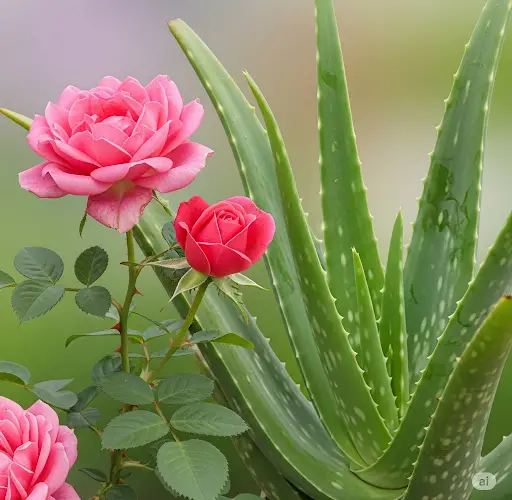Growing roses from cuttings is a satisfying way to propagate your favorite varieties without having to buy new plants. While traditional rooting methods often rely on commercial hormones or synthetic products, many gardeners are now turning to natural alternatives. One of the most effective and eco-friendly methods uses aloe vera—a common houseplant with powerful healing and growth-promoting properties.
Using aloe vera to root rose cuttings offers several advantages. It’s safe, natural, and accessible. Better yet, it increases the success rate of propagation by encouraging strong root development while protecting the cutting from infections. Here’s everything you need to know about this clever gardening trick.
Why Aloe Vera Works for Plant Propagation
Aloe vera is well known for its soothing gel, rich in vitamins, enzymes, amino acids, and plant hormones. These compounds are not only beneficial to human skin but also stimulate plant cell regeneration and root growth.
Key benefits of using aloe vera for rooting cuttings include:
-
Natural rooting hormones: Aloe contains auxins and gibberellins, which promote root formation.
-
Antibacterial and antifungal properties: Helps prevent rot and infections in the cutting.
-
Moisture retention: The gel keeps the cutting hydrated during the critical first days.
-
Nutrient supply: Provides a gentle nutrient boost that aids in early growth.
What You’ll Need
To try this method at home, gather the following:
-
Healthy rose cuttings (10–15 cm long)
-
A mature aloe vera leaf (or store-bought organic aloe vera gel)
-
A clean, sharp knife or pruning shears
-
Small pots or containers
-
Potting mix (well-draining, preferably with sand or perlite)
-
A transparent plastic bag or plastic bottle (to create a mini greenhouse)
Step-by-Step Guide: How to Root Roses Using Aloe Vera
Step 1: Prepare the Rose Cuttings
Choose a healthy stem from a mature rose bush, preferably one that has just finished blooming. Cut a 10–15 cm section, ideally just below a node (the point where a leaf emerges). Remove any leaves or flowers from the lower half of the cutting, leaving a couple of leaves at the top.
Step 2: Harvest the Aloe Vera Gel
Cut a thick aloe vera leaf from the base of the plant. Slice it open lengthwise and scoop out the gel using a spoon. If using store-bought aloe gel, ensure it is pure and free from added chemicals.
Step 3: Coat the Cuttings in Aloe
Dip the cut end of each rose cutting into the aloe gel, making sure it is well coated. You can also insert the cutting directly into a piece of fresh aloe leaf, which acts as both a rooting chamber and a nutrient source.
Step 4: Plant the Cutting
Fill a small pot with moist, well-draining soil. Make a small hole in the center and gently insert the cutting, taking care not to scrape off the aloe coating. Firm the soil around the base to provide support.
Step 5: Create a Humid Environment
To help retain humidity, cover the pot with a clear plastic bag or a plastic bottle with the bottom cut off. This creates a greenhouse effect, keeping the air around the cutting moist and warm, which promotes root development.
Step 6: Place in Indirect Sunlight
Keep the pot in a bright location but out of direct sunlight. Water lightly when the soil begins to dry, making sure not to overwater, as this can cause rot.
Step 7: Monitor and Transplant
In 3 to 4 weeks, check for root development by gently tugging the cutting. If you feel resistance, roots have formed. At this point, you can remove the plastic cover and allow the plant to adjust to normal conditions. Once established, transplant it to a larger pot or directly into the garden.
Additional Tips for Success
-
Always use sterilized tools to prevent infections.
-
Avoid using thick, woody stems for cuttings—opt for semi-softwood for better results.
-
Don’t rush the process; rooting takes time, and patience is key.
-
You can combine aloe vera with cinnamon powder or honey for additional antifungal protection.
-
If you’re propagating multiple cuttings, use separate containers to reduce the risk of spreading disease.
Why This Method is Worth Trying
Rooting rose cuttings in aloe vera is more than just a clever gardening hack—it’s a sustainable and effective way to propagate plants naturally. Aloe vera provides a protective, nutrient-rich environment that helps cuttings survive the critical early stages of growth. It’s safe for the plant, gentle on the environment, and delivers excellent results.
Whether you’re a beginner or a seasoned gardener, this method can help you multiply your roses without spending money on synthetic rooting hormones. Give it a try, and enjoy the satisfaction of growing a beautiful rose bush from just a single stem—powered by nature’s own miracle plant.



